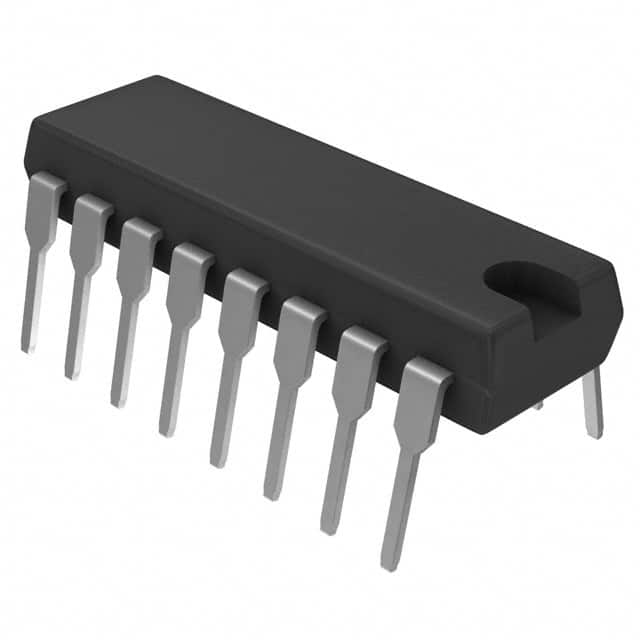Encyclopedia Entry: 74VHC161N
Product Overview
Category
The 74VHC161N belongs to the category of integrated circuits (ICs) and specifically falls under the family of digital counters.
Use
This IC is primarily used for counting purposes in various electronic applications. It can be employed in digital systems where sequential counting or frequency division is required.
Characteristics
- The 74VHC161N is a synchronous presettable binary counter.
- It operates on a supply voltage range of 2.0V to 5.5V, making it suitable for both low-power and standard applications.
- This IC offers high-speed operation with a maximum clock frequency of 200 MHz.
- It features asynchronous reset and parallel load capabilities, allowing for flexible control over the counting process.
- The 74VHC161N is designed to have low power consumption and high noise immunity.
Package and Quantity
The 74VHC161N is available in a 16-pin DIP (Dual In-line Package) format. Each package contains one IC.
Specifications
- Supply Voltage Range: 2.0V to 5.5V
- Maximum Clock Frequency: 200 MHz
- Number of Counting Stages: 4
- Input/Output Logic Level: CMOS/TTL compatible
- Operating Temperature Range: -40°C to +85°C
Pin Configuration
The detailed pin configuration of the 74VHC161N is as follows:
┌───┬───┐
1 │CLR│ VCC
2 │CLK│ GND
3 │P0 │ Q0
4 │P1 │ Q1
5 │P2 │ Q2
6 │P3 │ Q3
7 │PL │ QD
8 │ENP│
9 │ENT│
10 │D0 │
11 │D1 │
12 │D2 │
13 │D3 │
14 │LD │
15 │RC │
16 │QD │
└───┴───┘
Functional Features
- Synchronous Counting: The 74VHC161N performs counting operations synchronously with the clock signal.
- Presettable Counter: It allows for presetting the initial count value using parallel inputs (P0-P3) and the load (LD) input.
- Asynchronous Reset: The counter can be reset to its initial state asynchronously by applying a low logic level to the clear (CLR) input.
- Carry Output: The carry output (QD) provides a signal indicating when the maximum count value has been reached.
Advantages and Disadvantages
Advantages: - Wide supply voltage range enables compatibility with various systems. - High-speed operation facilitates efficient counting in time-critical applications. - Low power consumption contributes to energy-efficient designs. - Asynchronous reset and parallel load capabilities offer flexibility in controlling the counter.
Disadvantages: - Limited number of counting stages (4) may not be sufficient for certain complex applications. - Lack of built-in error detection or correction mechanisms.
Working Principles
The 74VHC161N operates based on synchronous binary counting principles. It utilizes flip-flops and combinational logic to increment the count value on each rising edge of the clock signal. The preset inputs allow for setting an initial count value, while the asynchronous reset input resets the counter to zero. The carry output indicates when the maximum count value has been reached.
Application Field Plans
The 74VHC161N finds applications in various fields, including: 1. Digital frequency dividers 2. Industrial automation systems 3. Communication equipment 4. Consumer electronics 5. Automotive electronics
Alternative Models
Some alternative models that offer similar functionality to the 74VHC161N include: - CD74HC161E - SN74HC161N - MC74HC161N - 74HCT161N
These alternatives can be considered based on specific requirements and availability.
In conclusion, the 74VHC161N is a versatile synchronous presettable binary counter IC with various applications in digital systems. Its high-speed operation, low power consumption, and flexible control features make it a valuable component in electronic designs.
Word Count: 530
Lista 10 Vanliga frågor och svar relaterade till tillämpningen av 74VHC161N i tekniska lösningar
Sure! Here are 10 common questions and answers related to the application of 74VHC161N in technical solutions:
Q: What is the 74VHC161N? A: The 74VHC161N is a 4-bit synchronous binary counter with asynchronous reset, commonly used in digital circuits.
Q: What is the maximum clock frequency supported by the 74VHC161N? A: The 74VHC161N can operate at a maximum clock frequency of 200 MHz.
Q: How many outputs does the 74VHC161N have? A: The 74VHC161N has four outputs, representing the four bits of the binary counter.
Q: Can the 74VHC161N be cascaded to create larger counters? A: Yes, multiple 74VHC161N counters can be cascaded together to create larger counters with more bits.
Q: Does the 74VHC161N require an external clock signal? A: Yes, the 74VHC161N requires an external clock signal to increment the counter.
Q: Can the 74VHC161N count in both up and down directions? A: No, the 74VHC161N can only count in the upward direction (from 0 to 15).
Q: What is the power supply voltage range for the 74VHC161N? A: The 74VHC161N operates with a power supply voltage range of 2.0V to 5.5V.
Q: How does the asynchronous reset work in the 74VHC161N? A: The asynchronous reset input (MR) allows you to reset the counter to 0 at any time, regardless of the clock signal.
Q: Can the 74VHC161N be used in battery-powered applications? A: Yes, the 74VHC161N is suitable for battery-powered applications due to its low power consumption.
Q: What are some typical applications of the 74VHC161N? A: The 74VHC161N can be used in various applications such as frequency dividers, event counters, digital clocks, and control systems.
Please note that these answers are general and may vary depending on specific circuit designs and requirements.


